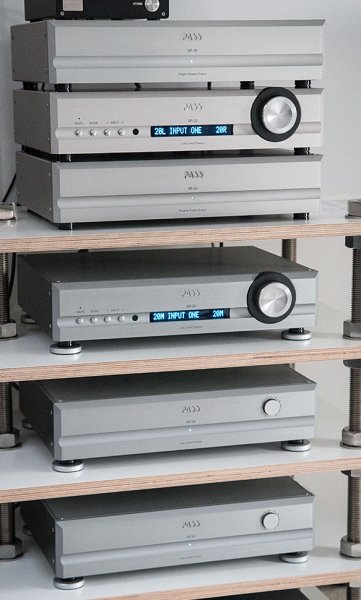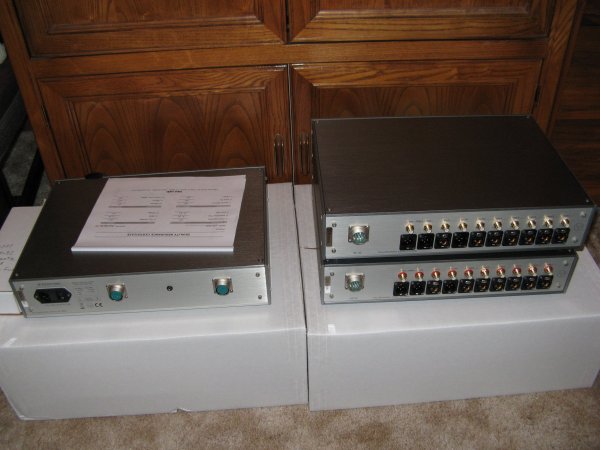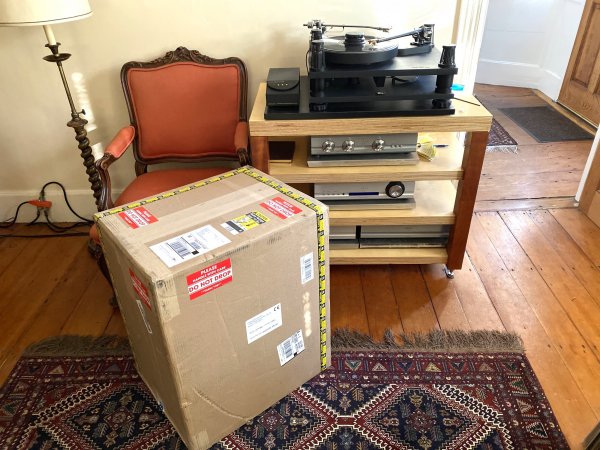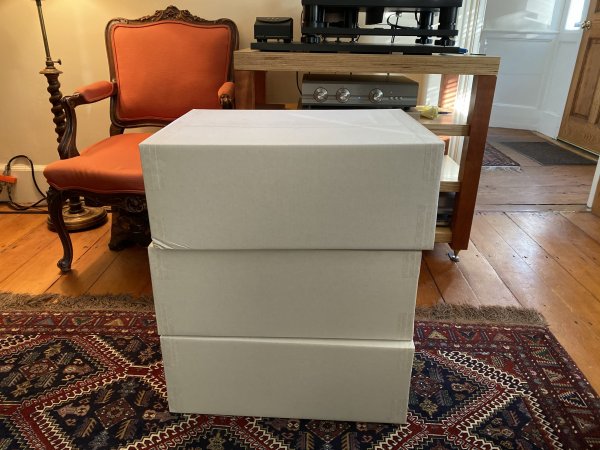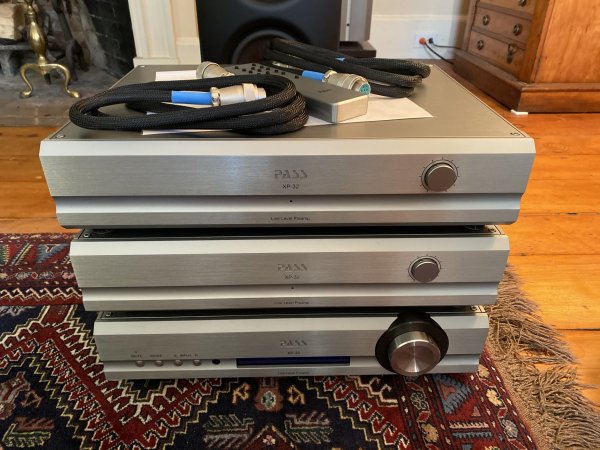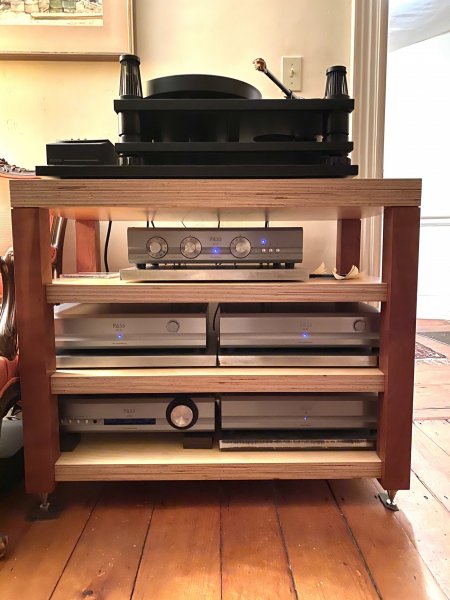Pass Labs XP-32 First Critical Listen
Prior to my comments below I had white and pink noise going thru the XP-32 preamp with its balanced outputs loaded with 22K resistor loads for a week. I alternated the noise sources every other day. Hopefully this will help reduce the break-in time some. With the previous XP22 preamp I used the noise source break-in for two weeks. I still felt it took nearly 2 months to fully settle into its final voicing. I play the system so seldom that this may another reason for the long break-in time that I observed even though it was powered on the entire time.
Some general comments first: I’m a rather critical listener, and less apt to say something sounds better just because it is sounds different. I do not expect my comments on this initial listen are going to be the final word on my thoughts going forward. I’ll likely formulate some of the preamps weaknesses as I listen to it more over time. Since the XP-22 was the most recent preamp being utilized in my system many of my XP-32 comments will likely reflect the differences I hear between these two preamps. I have used the Berkeley RS DAC as the volume control to get repeatability in level with the preamp set for unity gain (179). I have a varied list of music that I have volume level setting for DAC to get repeatability in my listening sessions. With the entire system now having 23 hours of being powered on the DAC and N10 Aurender unit clocks should be settled in better than the initial listen that I did yesterday. I’m using my XA-160.5 amplifiers and curious how the XP-32 will sound in this paring.
The Strengths I Noted with the XP-32 are as Follows:
1) This preamp makes it hard to peg it as a solid-state unit. The transparency of the unit would easily pass for SOA tube unit, but without the associated tube noise. This design surely has blurred the difference between SS and tube units, which is a first for myself.
2) This preamp has the best overall spectral balance that I have ever experienced in a preamp. I have not heard the Pass Labs Xs preamp, but at half the price, I suspect this unit would compare well. I now understand why Desmond would be willing to use this unit in his own system (as Wayne Colburn noted to me previously). An example: I have always questioned the sound quality on Keith Johnson’s symphony recordings. It always seemed like he had incorrect microphone placement, which caused many instruments groups sound anemic IMO. Playing some of this music today showed a well-balanced recording, which tells me Wayne has fixed my problem in the reproduction chain.
3) The harmonics of instruments are more fully flushed out than the XP-22. This is very evident in piano and string instruments. This brings a new level of realism to my system.
4) The timing of those harmonics and the amount of detail has improved. Everything sounds more realistic and playing in free space. Again, more tube-like performance. The decay of notes seems to linearly go blackness. The XA-160.5 amps are champs at natural sounding instrument decay in my book. Now with the XP-32 as the signal source the decay really brings noticeably improved realism to the picture.
5) The soundstage images have more equal weighting than I have ever heard before…what does that mean? The best photograph analogy would be the central images usually have good focus in a decent Hi-End system, but it seems they are taken with a wide aperture lens. The images deeper in the soundstage and off to the sides are there but not as well in focus. The outer images are not flushed out well with respect to the density of the sound in them and the full harmonic content and detail of the central images. The XP32 seems to be using a small aperture lens, so everything in the soundstage is in much better focus. The sounds are more saturated like the central image all across the sound stage depth and width. This brings improved realism and flow to the music. The soundstage portrays more saturated images in the soundstage with well recorded music. I believe this effect is highly related to the next effect I’m experiencing.
6) Now with all that acoustic energy being better focused (where it should be) the preamp seems to handle complex and loud passages of music more like a tube design. You do not get the urge to turn down passages because they get irritating and compressed sounding during loud and complex music. I found myself even seeking out music that I found irritating before and found the XP-32 allowed me to play them through to the end, which I had not wanted to do previously.
7) All these above traits come together to good effect. It is so easy to follow individual instruments or voices. The improved spectral balance and the added detail in the sound stage has made hand claps on live recordings sound much more flushed out and real. I use the well recorded Alison Krause & Union Station live album for one of my hand claps references (“Stay” cut and others).
Weakness?
The only thing I’m questioning with the XP-32, compared to the XP-22, is that maybe the dynamics seem a bit more muted. My thought process on this has led me to the considering that the sound energy is more uniformly spread around the sound stage (in the proper image locations) with the XP-32. The images having more body, spread more evenly/correctly, which makes the previously center centric image sound of the XP-22 sound more dynamic in comparison.
Summary/Comments:
This preamp definitely has the effect of pulling you into the music. Your brain just does not have to work as hard to fill in the mental sonic gaps. We are asking our brains to do this all time. We have to mentally complete the music as we know it from our past live performance experiences. The XP-32 IMO achieves a few steps towards a more realistic and enjoyable experience.
On the surface the XP-32 looked like it offered move balanced inputs and the useful additional buffered Slave outputs. Given the large price-point difference, I was hoping, but not really expecting to hear this much of an improvement with the XP-32. Wayne Colburn has managed evoke some magic in this unit and needs to be commended. Even a jaded, performance orientated, audiophile like myself is likely to become more of a music lover with this unit in the system.
I admit that was a little worried, given that the XP-32 was likely designed with the PT 8 amplifiers in mind. This might have meant that it would not mate up as well with the sonic character of my older XA-160.5 amps. I find that my old XA-160.5 amps were able to portray a higher level of detail and finesse with the XP-32 feeding them, which banished my initial reservations. I find it interesting that the amplifier was not the weak link and allowed me to hear the much improved signal the XP-32 was generating. More time is need to see where the XP-32 finally ends up sonically. I do not think it will be leaving my system any time soon….
Prior to my comments below I had white and pink noise going thru the XP-32 preamp with its balanced outputs loaded with 22K resistor loads for a week. I alternated the noise sources every other day. Hopefully this will help reduce the break-in time some. With the previous XP22 preamp I used the noise source break-in for two weeks. I still felt it took nearly 2 months to fully settle into its final voicing. I play the system so seldom that this may another reason for the long break-in time that I observed even though it was powered on the entire time.
Some general comments first: I’m a rather critical listener, and less apt to say something sounds better just because it is sounds different. I do not expect my comments on this initial listen are going to be the final word on my thoughts going forward. I’ll likely formulate some of the preamps weaknesses as I listen to it more over time. Since the XP-22 was the most recent preamp being utilized in my system many of my XP-32 comments will likely reflect the differences I hear between these two preamps. I have used the Berkeley RS DAC as the volume control to get repeatability in level with the preamp set for unity gain (179). I have a varied list of music that I have volume level setting for DAC to get repeatability in my listening sessions. With the entire system now having 23 hours of being powered on the DAC and N10 Aurender unit clocks should be settled in better than the initial listen that I did yesterday. I’m using my XA-160.5 amplifiers and curious how the XP-32 will sound in this paring.
The Strengths I Noted with the XP-32 are as Follows:
1) This preamp makes it hard to peg it as a solid-state unit. The transparency of the unit would easily pass for SOA tube unit, but without the associated tube noise. This design surely has blurred the difference between SS and tube units, which is a first for myself.
2) This preamp has the best overall spectral balance that I have ever experienced in a preamp. I have not heard the Pass Labs Xs preamp, but at half the price, I suspect this unit would compare well. I now understand why Desmond would be willing to use this unit in his own system (as Wayne Colburn noted to me previously). An example: I have always questioned the sound quality on Keith Johnson’s symphony recordings. It always seemed like he had incorrect microphone placement, which caused many instruments groups sound anemic IMO. Playing some of this music today showed a well-balanced recording, which tells me Wayne has fixed my problem in the reproduction chain.
3) The harmonics of instruments are more fully flushed out than the XP-22. This is very evident in piano and string instruments. This brings a new level of realism to my system.
4) The timing of those harmonics and the amount of detail has improved. Everything sounds more realistic and playing in free space. Again, more tube-like performance. The decay of notes seems to linearly go blackness. The XA-160.5 amps are champs at natural sounding instrument decay in my book. Now with the XP-32 as the signal source the decay really brings noticeably improved realism to the picture.
5) The soundstage images have more equal weighting than I have ever heard before…what does that mean? The best photograph analogy would be the central images usually have good focus in a decent Hi-End system, but it seems they are taken with a wide aperture lens. The images deeper in the soundstage and off to the sides are there but not as well in focus. The outer images are not flushed out well with respect to the density of the sound in them and the full harmonic content and detail of the central images. The XP32 seems to be using a small aperture lens, so everything in the soundstage is in much better focus. The sounds are more saturated like the central image all across the sound stage depth and width. This brings improved realism and flow to the music. The soundstage portrays more saturated images in the soundstage with well recorded music. I believe this effect is highly related to the next effect I’m experiencing.
6) Now with all that acoustic energy being better focused (where it should be) the preamp seems to handle complex and loud passages of music more like a tube design. You do not get the urge to turn down passages because they get irritating and compressed sounding during loud and complex music. I found myself even seeking out music that I found irritating before and found the XP-32 allowed me to play them through to the end, which I had not wanted to do previously.
7) All these above traits come together to good effect. It is so easy to follow individual instruments or voices. The improved spectral balance and the added detail in the sound stage has made hand claps on live recordings sound much more flushed out and real. I use the well recorded Alison Krause & Union Station live album for one of my hand claps references (“Stay” cut and others).
Weakness?
The only thing I’m questioning with the XP-32, compared to the XP-22, is that maybe the dynamics seem a bit more muted. My thought process on this has led me to the considering that the sound energy is more uniformly spread around the sound stage (in the proper image locations) with the XP-32. The images having more body, spread more evenly/correctly, which makes the previously center centric image sound of the XP-22 sound more dynamic in comparison.
Summary/Comments:
This preamp definitely has the effect of pulling you into the music. Your brain just does not have to work as hard to fill in the mental sonic gaps. We are asking our brains to do this all time. We have to mentally complete the music as we know it from our past live performance experiences. The XP-32 IMO achieves a few steps towards a more realistic and enjoyable experience.
On the surface the XP-32 looked like it offered move balanced inputs and the useful additional buffered Slave outputs. Given the large price-point difference, I was hoping, but not really expecting to hear this much of an improvement with the XP-32. Wayne Colburn has managed evoke some magic in this unit and needs to be commended. Even a jaded, performance orientated, audiophile like myself is likely to become more of a music lover with this unit in the system.
I admit that was a little worried, given that the XP-32 was likely designed with the PT 8 amplifiers in mind. This might have meant that it would not mate up as well with the sonic character of my older XA-160.5 amps. I find that my old XA-160.5 amps were able to portray a higher level of detail and finesse with the XP-32 feeding them, which banished my initial reservations. I find it interesting that the amplifier was not the weak link and allowed me to hear the much improved signal the XP-32 was generating. More time is need to see where the XP-32 finally ends up sonically. I do not think it will be leaving my system any time soon….


